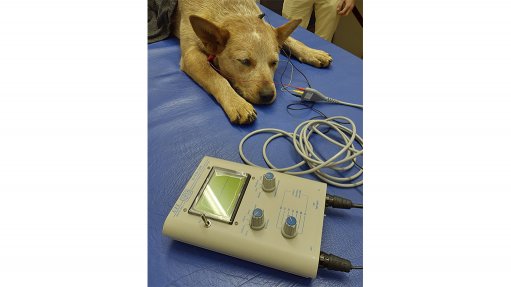
The University of Pretoria’s (UP's) Onderstepoort Veterinary Academic Hospital (OVAH), in the Faculty of Veterinary Science, has invested in a Brainstem Auditory Evoked Response (BAER) device to test deafness in dogs.
The veterinary hospital is currently testing 20 to 30 dogs a month, most of which are puppies. The new device being used at OVAH to do this test is the American-manufactured UFI BAERCOM, which quickly and painlessly assesses the dog’s level of hearing or deafness.
“We had an older, larger, clumsy device prior to this one, as we have been doing deafness testing for some time, but it had become unreliable to the point that we could not do any BAER tests for about two years,” says OVAH Small Animal Medicine section head and senior lecturer Dr Paolo Pazzi.
The BAER test detects electrical activity in the cochlea and auditory pathways in the brain in much the same way that an antenna detects television signals. The test is painless, and the puppy or dog is usually lightly sedated as movement interferes with the results.
Small electrodes are positioned on the animal’s head and connected to the device, which reads and interprets the brain’s response to a specific clicking noise generated by it.
Each ear is tested individually as the dog may only be deaf in one ear. If they can hear in the ear, the machine’s screen will show a recording of ‘waves’ of varying sizes and depths, but if they are deaf then the screen shows a recording of almost flat lines.
Once both ears have been tested, the sedation is reversed, and a copy of the results is shared with the owner.
Dogs with congenital deafness can be trained just like a hearing dog (using hand signals instead of speaking) and there are trainers who can assist with this. Many deaf dogs cope very well with hand signals, Pazzi says.
“Deafness in the dog – and cat – population is low overall, but responsible breeders of predisposed breeds should ensure their puppies can hear and that deafness is not carried in their breeding lines,” he says.
Congenital deafness has been described in more than 80 breeds, but is most commonly diagnosed in Dalmatians, Bull Terriers, Australian Cattle Dogs, English Setters, English Cocker Spaniels and Boston Terriers. There is an association between deafness and pigmentation, with white dogs predisposed and even more so if they are white with blue eyes.
“It is important for dog breeders and people getting a puppy to make sure there is no congenital deafness in the line, particularly in breeds that are more susceptible to it. Other reasons for testing include owners who are concerned that the dog they have adopted is deaf, or if their elderly dog has become deaf.”